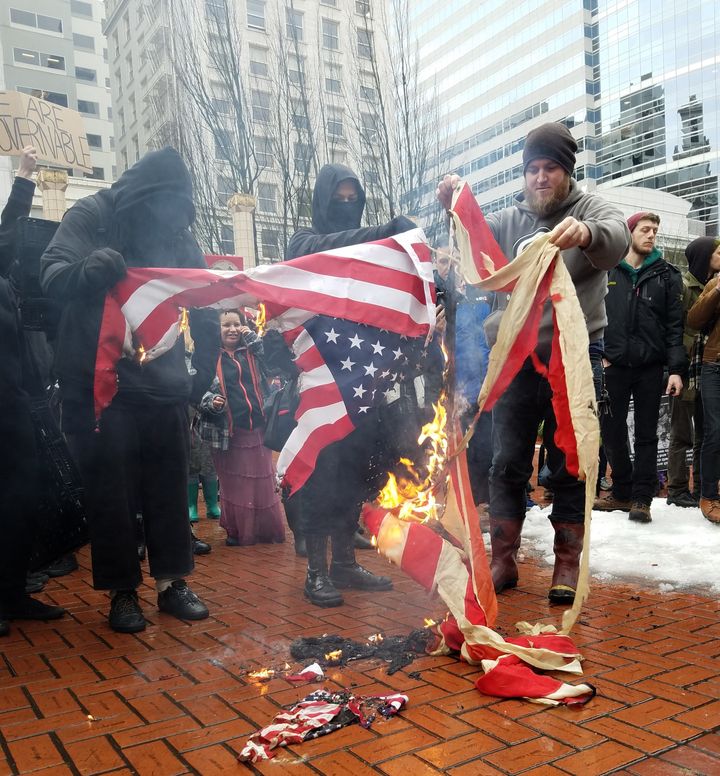
January 20, 2017 - The Flag Burning Extravaganza at Pioneer Square, Portland, OR
In President Trump’s short-yet-apocalyptic inauguration address, which was drafted in part by noted white supremacist Steve Bannon, Trump acknowledged the fracturing of American society and then refused to take any responsibility for it. While Trump used the buzzword “unity” over and over again, the rest of his words continued to widen the divide.
Trump’s America is a step into an Orwellian future. In 1984, the ruling class uses a new form of language, Newspeak, an “ambiguous euphemistic language used chiefly in political propaganda”. It is a deliberate manipulation of truth into lies, such as “2+2=5”. The official slogan of the state is “War is peace. Freedom is slavery, Ignorance is strength.” Newspeak was designed to “limit political thought” through control of language. In Trump’s America, we call Newspeak “alternative facts”.
While most of Portland, Oregon—74 percent—either voted for Hillary Clinton or against Donald Trump, like anywhere else in this country the population is on edge. Following the election in November, the city witnessed three days of massive protests accompanied by property destruction by a local anarchist collective. We have all felt it reverberating through our social networks for months. Weeks before inauguration, the city braced itself for another kind of protest, the “Flag Burning Extravaganza” in Portland’s Pioneer Square.
While burning flags is often viewed as distasteful or disrespectful, it is not against the law. In fact, the US Supreme Court has ruled—twice—that it is a protected by the first amendment. The event was actually inspired by Trump himself, who had mused in a Tweet that the punishment for burning a flag should be a year in prison or loss of citizenship. It is exactly these dangerous and willfully ignorant statements that have forced citizens to choose sides; blindly support a megalomaniac with no respect for the Constitution or rule of law (unless it benefits him) or support an event that involves offending many.
But what is actually worse? Offense or harm? If someone spends their own money on a flag and chooses to burn it, is there an actual victim? Just because it doesn’t feel “right” doesn’t mean it is “wrong”. On the other hand, Trump has, in speech and action, left and is continuing to leave a trail of real human victims in his wake. In reality and in the eyes of the law, nobody’s feelings actually matter.
Friday morning, as Trump continually repeated the words “unity” and proclaimed he would “be a leader for all Americans”, the protests were already filling the streets of Washington, D.C. As he continued to spit out the word, “unity”, more and more American friends, families, acquaintances and coworkers drifted even further apart over his rhetoric, actions and proposed policies. A rift opened up in Oregon as people took to the streets and lit their flags.
In the original November protests an anarchist collective broke windows (but injured no humans) and became the representation of the protests. Despite the destruction being perpetrated by a very small subset of the crowd, media sensationalized it as a riot and the message of the entire protest was lost. By being forced to lay judgement on the extreme event, one is chooses their cultural identity.
While riots, protests and heavy police force make for great television, in focusing on the damage, regular citizens who otherwise agree with each other find themselves on very different sides of the issue. The destruction takes on a cultural and moral identity when it is the feature and makes people feel they must fall on one side of a conflict or another, instead of meeting somewhere in the middle. It also whips up support for aggressive anti-First Amendment policies.
While media coverage of the Portland election protests focused heavily on the small anarchist collective—which made up less than 20 people out of a crowd of hundreds—the heart of the issue was again lost by the TV cameras. On the second night of protests, many different local activist groups became one organized super-group that encouraged neighborhood specific meetups for community organizing—the Portland Resistance.
On inauguration day, the Portland Police Department, under new mayor Ted Wheeler, were ready to shut down the protests and so aggressively dispersed the crowd early in the evening that they shot, tackled and arrested bystanders.
Early on in the day, the Portland Police were preparing for battle. By 1pm Pioneer Square was more full of cops and cameras salivating for action than actual protesters.
At 2:30, a train rolled up on the square and a group of red-hatted protestors held up their hands as they disembarked the train and walked into the square chanting “hands up, don’t shoot”. The small assembled group cheered, but within minutes, the conflict began.
A religious group appeared at the edge of the crowd and began shouting, “I’m for President Trump!” and “Today is the day of salvation, repent!” and “You all hate god, you don’t deserve the grace of god”.
The assembled crowd moved in and surrounded them. Protest security provided by the Portland Resistance—identified by yellow armbands—tried to prevent the hostile engagements. The anarchists even stepped in and helped quell the fights. It is not alternative fact that the anarchists held the moral authority over the pious and hate-filled Christians in this moment.
At 2:45 it stopped raining and the flag burning began. One after one, small groups of 3 to 5 people equipped with lighter fluid and flags of all sizes began burning. The promised counter pro-Trump protesters with fire extinguishers never showed, but the cameras were in full force. For every flag burner, there were about 20-50 cameras pointed, including cell phones. One flag started shooting large flames, the crowd cheered and the cameras snapped. An woman sat down and warmed her hands with a burning flag. About fifteen minutes later, there were no more flags left to burn.
One woman, equipped with a backpack full of plastic panty liners and maxi-pads began sticking them to the end of protest sign sticks, spraying them with lighter fluid and using them to light more flags. In the absence of more flags to burn, she opened more maxi pads and proceeded to burn them while posing happily for a sea of cameras. She would forever live on in internet fame as flaming maxi-pad girl in conservative memes—a completely absurd scene charged by feelings and not logic or reality.
A sea of cameras snapped the flags burning and they immediately went viral, allowing those not present to choose a radical cultural line to stand on, despite the event being a 15 minute flash in the pan compared to the hundreds of people assembling and demanding for their voices to be heard. But nobody can deny the truth—all press is good press.
After the flag burning, the group grew to fill the square and beginning spilling into the street. A few people in the crowd wore yellow Stars of David with the word “Jude” in the center, a direct reference to the identifying armbands Nazi Germany required Jewish people to wear during the Holocaust.
While many feel it is an extreme comparison, it is one firmly rooted in the reality of history. The Holocaust began with an economic collapse, finger-pointing, divisions and then registries of people considered to be enemies of the state—similar to the Muslim registry Trump has proposed.
Those who turned up for the protests, while having diverse life experiences and opinions were united in one sentiment, “No KKK, No Fascist USA, No Trump.”
Is it true the Trump Administration fascist?
Well, in the words of former President Bill Clinton, that depends on what the definition of “is” is.
The Trump Administration has taken a page out of the Nazi playbook, by using deliberate falsehoods to appeal to supporters’ emotions rather than logic. Orwell’s 1984 was published in 1949 and Newspeak drew its roots in Adolf Hitler’s propaganda. Although, admittedly, Orwell probably couldn’t imagine that we would all willingly become Big Brother.
Trump can say the word “unity” over and over again, but it doesn’t make it so. According to pundits, Americans have constructed regional bubbles and harbor distrust and distaste for those outside their bubbles. Coastal “liberal elites” have been chastised for ignoring the “poor working class white man” despite white men historically being handed the reins to the nation without having to work as hard as women or people of color. Both these cultures clash in Portland—a city with both a history both rooted in progressive ideals but also white supremacy.
As Trump spoke to his tiny inauguration crowd promising to bring back jobs from fictional other-country despite the fact they have been taken forever by greed and automation in every-country, these poor working class white men chose to believe the fiction, to buy the newspeak, because it is convenient to them. The protestors, in contrast, are people whose lives are already inconvenient—people of color, students, LGBTQ people, the working poor and women. Reality is not a choice but an obligation for marginalized peoples, and neither was a man who ran on a platform of hating them.
